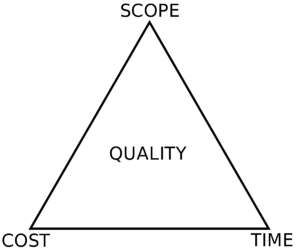The iron triangle as an analytical tool
| Line 58: | Line 58: | ||
== Application == | == Application == | ||
| − | Test. | + | One should not blindly assume that Quality is the most fitting constarint to their specific project. Take NASA for example; they... |
| + | [[File:File:IronTrinagle7zone.png|300px|thumb|right|Test.]] | ||
== Limitations == | == Limitations == | ||
Revision as of 16:00, 21 February 2021
Contents |
Abstract
This article aims to present the Iron Triangle (also known as Project Management Triangle, Project Triangle, and Triple Constraint Triangle) with a focus on Project Management through the perspective of Purpose. The Iron Triangle is an analytical tool based on the essential triple constraints of project management; Time, Cost, and Scope/Quality. While scope and quality cannot be directly interchangeable with each other, the choice of constraint definition varies through literature, whereas the PMI standards most often use Scope, and the British standards, Quality. This article is initially going to refer to the triple constraints including Scope, as PMI’s Project Management Body of Knowledge, a key reference of this article, uses this standard.
Regarding the application of the tool, PMI’s Project Management Body of Knowledge courses of action regarding the management of the triple constraints will firstly be briefly introduced. Then, various practical and strategic approaches to the application of the triple constraints will be presented. Here, the perspective of the Four Levels of Management (Managing Successful Projects with PRINCE2) will be included to illuminate how the Iron Triangle should not only be considered from a management perspective but also a delivering perspective. Lastly, it will be discussed how the Iron Triangle can be leveraged from representing a set of pre-defined specifications (classic view of projects) to an analytical tool focusing on value creation (state of the art view of projects) based on relevant success criteria. Here the methodology of conformance (value protection) vs. performance (value creation) will also be included.
Through above-presented observations, various limitations of the Iron Triangle will also inevitably emerge. These will be presented including varying takes on the Iron Triangle which could mitigate these limitations. Some of the limitations could be: The Iron Triangle does not include all constraints regarding project success. The perspective of which the constraints of the Iron Triangle are measured can have varying effects on the application of the tool. Also, even with the above-presented courses of action regarding the managing of constraints, the risk of unrealistic and uncertain measuring of the constraints could have critical consequences regarding the application of the tool.
The Iron Triangle and its most relevant variations
The Iron Triangle (also known as Project Management Triangle, Project Triangle, and Triple Constraint Triangle) is an essential tool that aims to present the concept of which project success should be understood. The Iron Triangle was proposed by Martin Barnes back in 1969 [1] [2] and has since then undertaken various different takes on changes, additions, and updates. Throughout time, the Iron Traingle has always been represented by the key project performance metrics that any project success is measured by, defined as constraints; namely Time and Cost [3] [1]. However, as extensively and thoroughly analysed by the rather up-to-date What is the Iron Triangle, and how has it changed? (2018) [3], it is presented that depending on the given project specifications and other varying debatable factors, either Quality, Scope, Performance, or Requirements are most often applied interchangeably as the triangle's third constraint. So, in other words, the Iron Triangle aims to represent the constraints of whether a project is delivered on time, within its budget, and to an agreed extend of quality, scope, performance, or requirement. Hereby, the main focus of the tool is defined to be Project Management, as some of the most cited project management standards have somewhat aligned views of protect success in comparison to the core principals of the Iron Triangle. For example, the Guide to the Project Management Body of Knowledge [4] presents a comparative overview of the success definition in Project, Program, and Portfolio Management as seen in the table below.
| Projects | Programs | Portfolios | |
|---|---|---|---|
| Success | Success is measured by product and project quality, timeliness, budget compliance, and degree of customer satisfaction. |
A program’s success is measured by the program’s ability to deliver its intended benefits to an organization, and by the program’s efficiency and effectiveness in delivering those benefits. |
Success is measured in terms of the aggregate investment performance and benefit realization of the portfolio. |
The concept of the Iron Triangle is an effective way of communicating the interrelationships between these central success criteria. It is typically depicted as a triangle with the criteria on the vertices. Movement of one criteria, for example in response to client demands or resource limitations, can put pressure on the other criteria. Failure in one constraint will likely lead to negative pressure on one or both of the other two (Mokoena et al, 2013, p. 814). This is sometimes expressed as “good, fast or cheap - pick two” (van Wyngaard et al, 2012, p. 1993). Misunderstanding or misinterpreting the Iron Triangle can lead to project failure despite effective management of all other aspects of a project (Mokoena et al, 2013, p. 813). Effectively managing the Iron Triangle has been found to be central to project success, however it has also been found that research into the Iron Triangle is “…one of the most overlooked fundamentals of project management” (Van Wyngaard et al, 2012, p. 1993). The Iron Triangle has become the standard for routinely assessing project performance (Pinto, 2010, p. 35).
Test [3]
Test [5]
Test. [4]
Test. [1]
Test. [6]
Test. [7]
Test. [8]
Test. [2]
Test. [4]
Application
One should not blindly assume that Quality is the most fitting constarint to their specific project. Take NASA for example; they...
Limitations
Test.
Annotated bibliography
Key references:
A guide to the Project Management Body of Knowledge (PMBOK guide), 6th Edition (2017)
Managing Successful Projects with PRINCE2, 6th Edition (2017)
Bibliography
- ↑ 1.0 1.1 1.2 Wright, Andrew, and Therese Lawlor-Wright. “Project Success and Quality: Balancing the Iron Triangle.” Project Success and Quality: Balancing the Iron Triangle, Taylor and Francis, 2018, pp. 171–177. doi:10.4324/9781351213271.
- ↑ 2.0 2.1 Vahidi, Ramesh & Greenwood, David. (2009). TRIANGLES, TRADEOFFS AND SUCCESS: A CRITICAL EXAMINATION OF SOME TRADITIONAL PROJECT MANAGEMENT PARADIGMS. 10.13140/2.1.2809.1520.
- ↑ 3.0 3.1 3.2 Pollack, J., Helm, J. and Adler, D. (2018), "What is the Iron Triangle, and how has it changed?", International Journal of Managing Projects in Business, Vol. 11 No. 2, pp. 527-547.
- ↑ 4.0 4.1 4.2 4.3 Project Management Institute, Inc. (2017). Guide to the Project Management Body of Knowledge (PMBOK® Guide) (6th Edition) - 2. Initiating Process Group. Project Management Institute, Inc. (PMI). pp. XXX. Retrieved from https://app.knovel.com/hotlink/pdf/id:kt011DXQ4C/guide-project-management/initiating-process-group
- ↑ AXELOS. Managing Successful Projects with PRINCE2 2017 Edition, The Stationery Office Ltd, 2017. pp. XXX. ProQuest Ebook Central, https://ebookcentral-proquest-com.proxy.findit.dtu.dk/lib/DTUDK/detail.action?docID=4863041.
- ↑ Roger Atkinson, Project management: cost, time and quality, two best guesses and a phenomenon, its time to accept other success criteria, International Journal of Project Management, Volume 17, Issue 6, 1999, Pages 337-342.
- ↑ Gabriella Cserháti, Lajos Szabó, The relationship between success criteria and success factors in organisational event projects, International Journal of Project Management, Volume 32, Issue 4, 2014, Pages 613-624. ISSN 0263-7863.
- ↑ Test. Pinto, J., Project Management: Achieving Competitive Advantage. New Jersey: Pearson Education, 2010, pp. 35-40.



